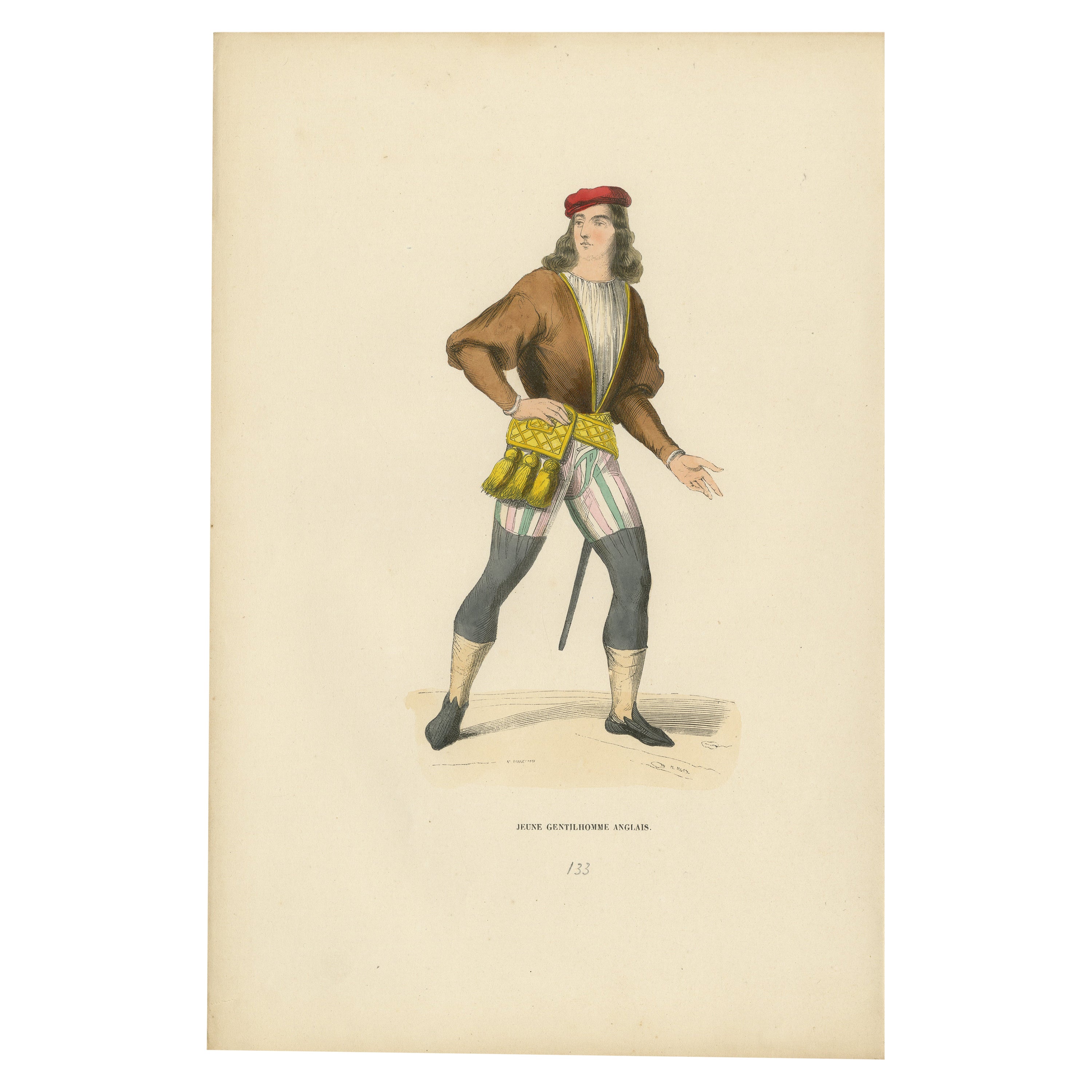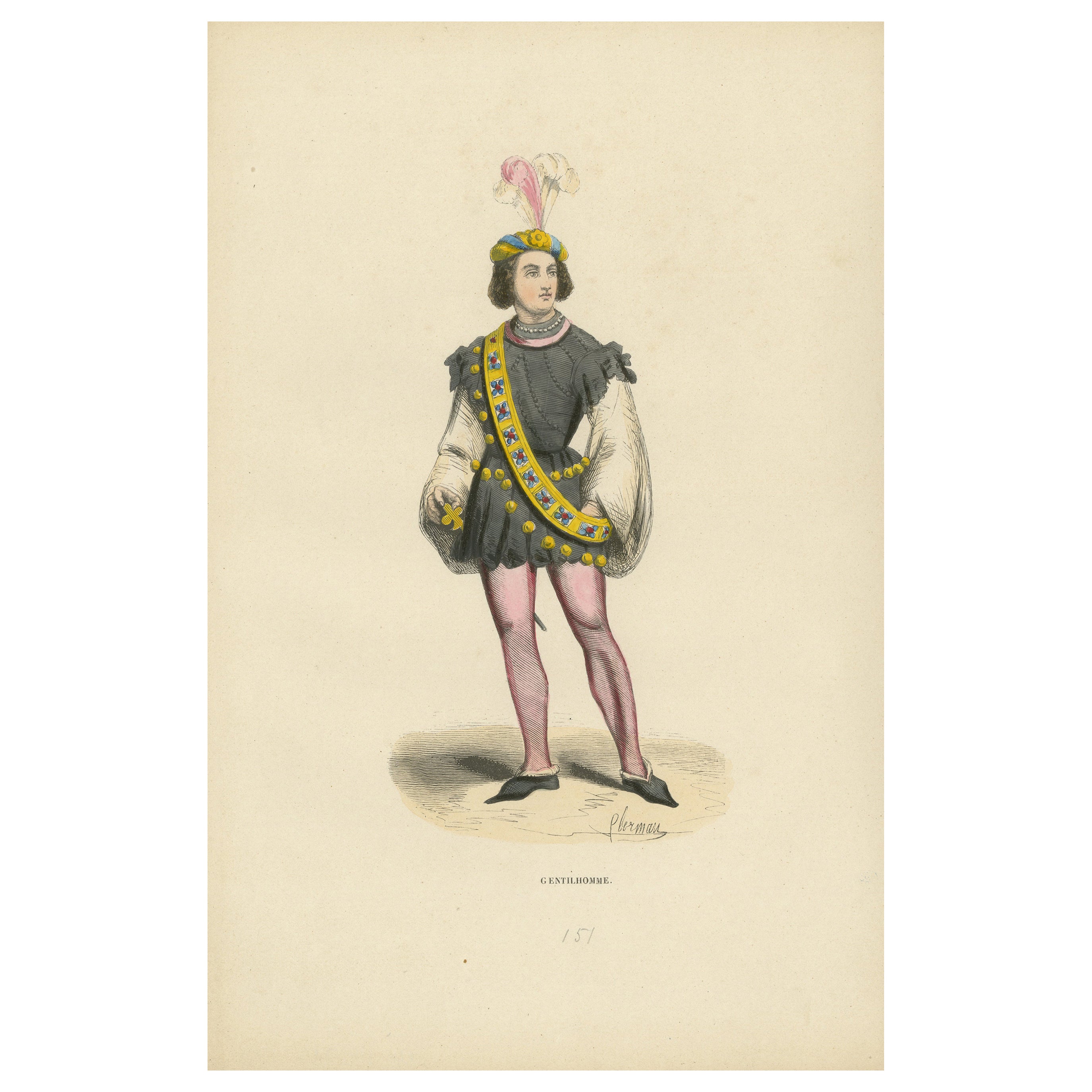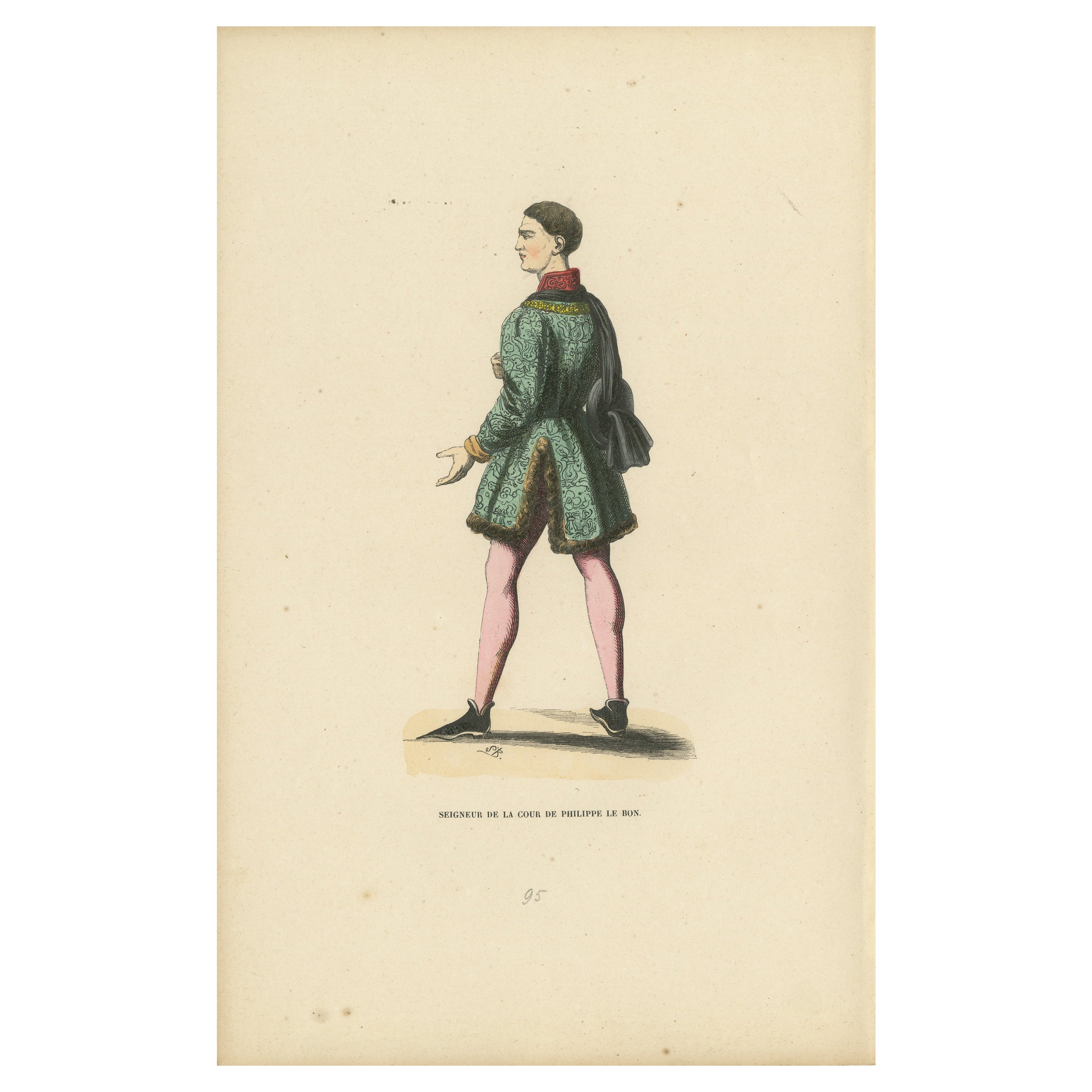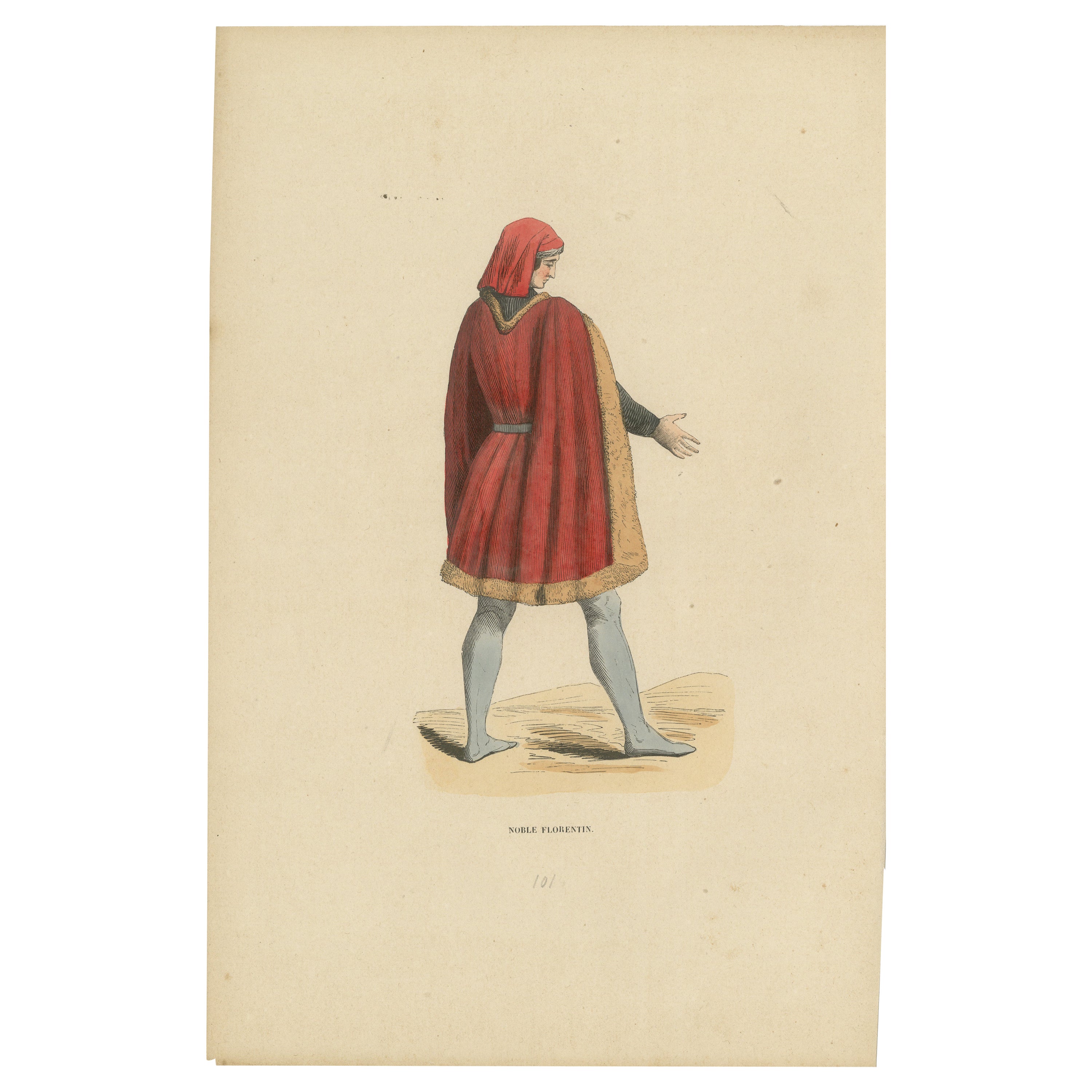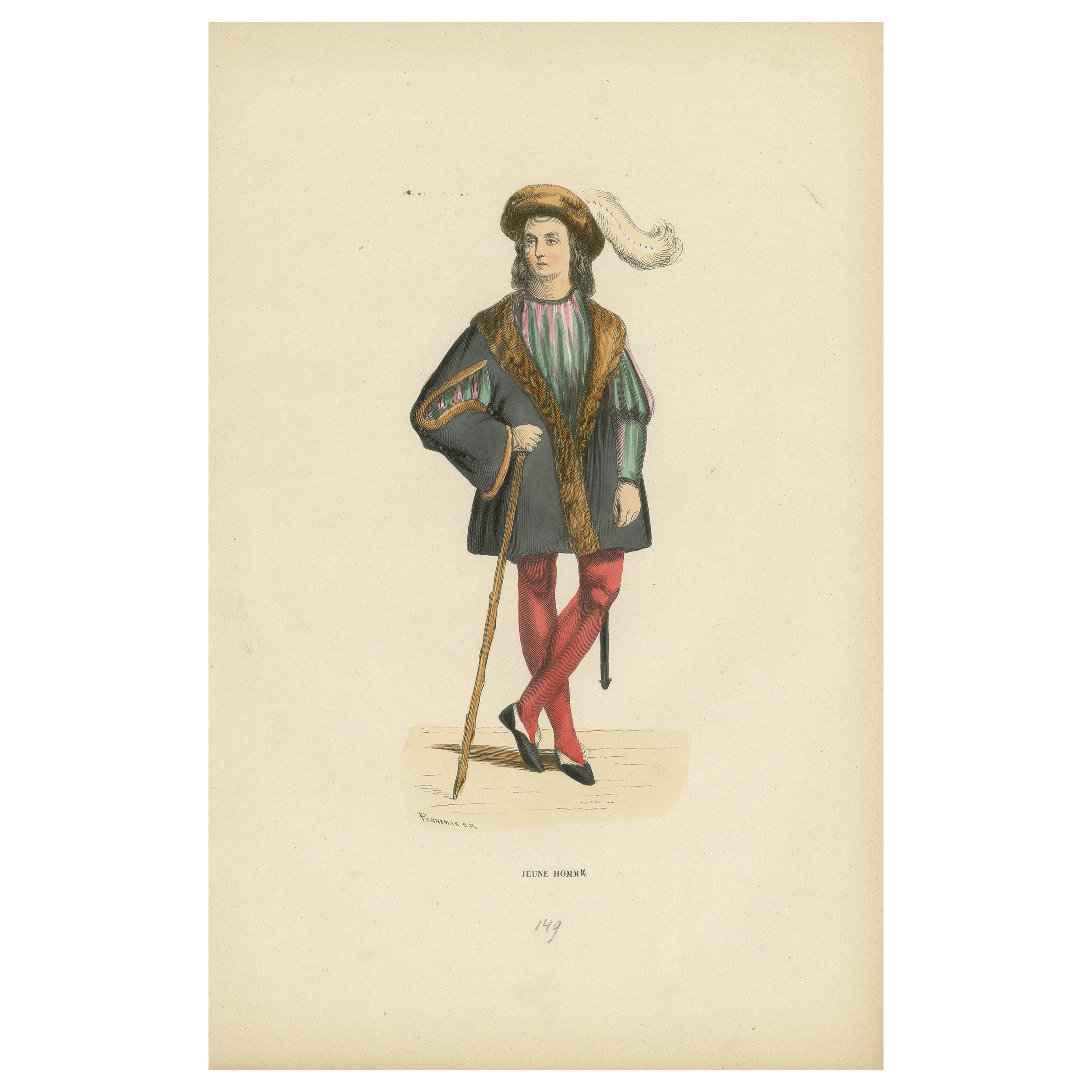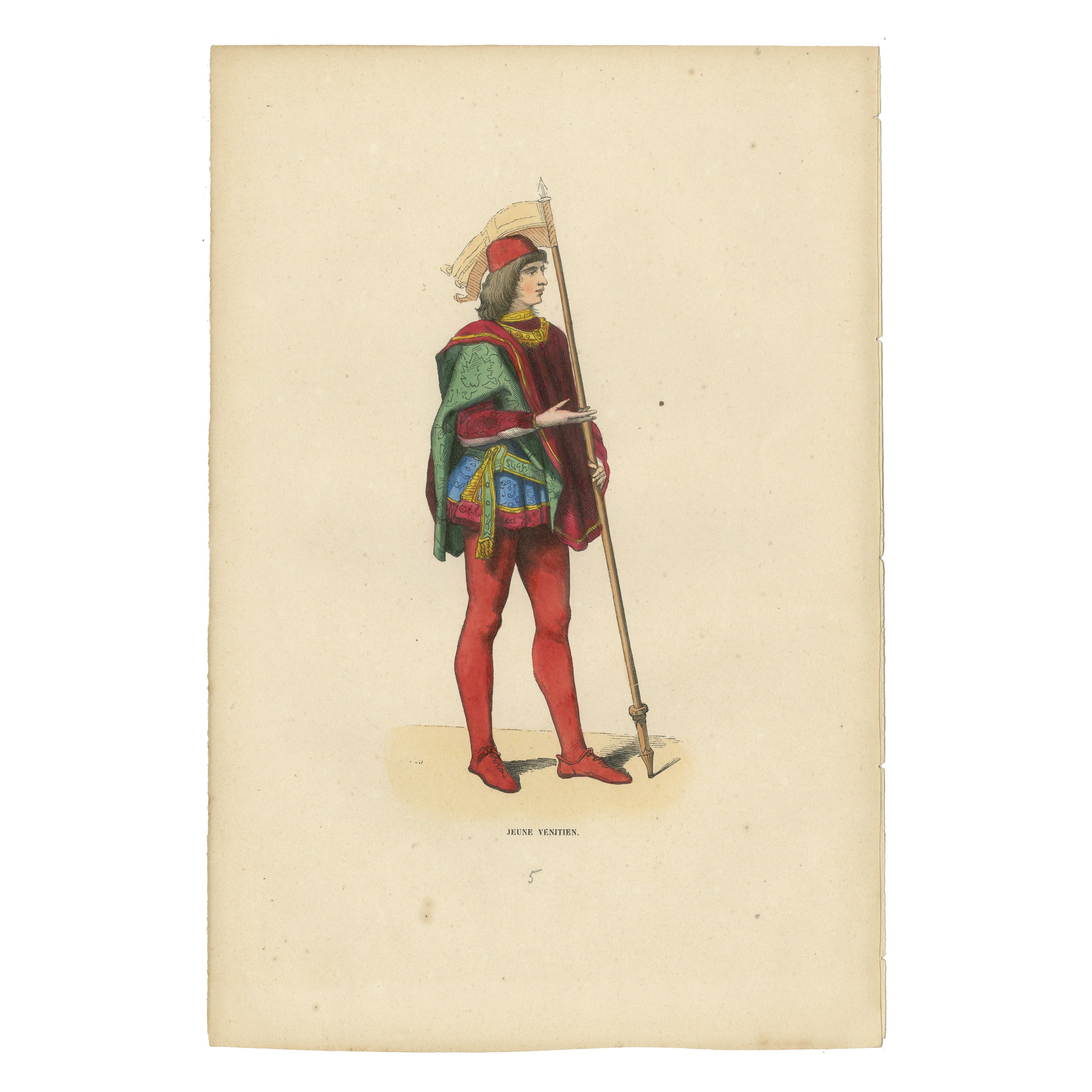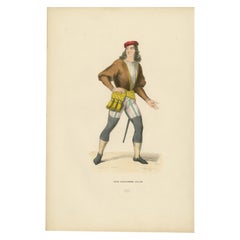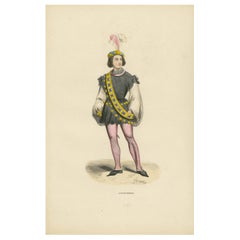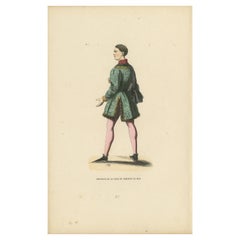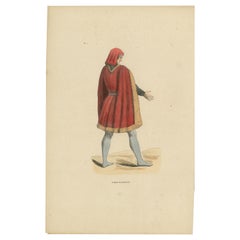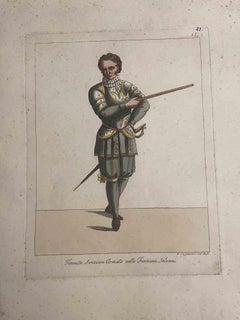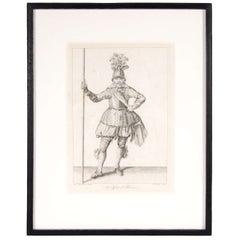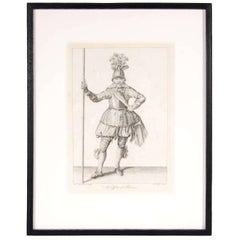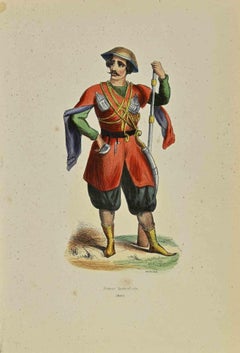Items Similar to The English Squire: A Portrait of Service and Style, Original Engraving of 1847
Want more images or videos?
Request additional images or videos from the seller
1 of 7
The English Squire: A Portrait of Service and Style, Original Engraving of 1847
$124.07
$155.0920% Off
£91.71
£114.6420% Off
€104
€13020% Off
CA$172.09
CA$215.1120% Off
A$187.61
A$234.5220% Off
CHF 99.13
CHF 123.9120% Off
MX$2,307.22
MX$2,884.0220% Off
NOK 1,232.63
NOK 1,540.7820% Off
SEK 1,160.35
SEK 1,450.4420% Off
DKK 791.91
DKK 989.8820% Off
About the Item
This antique hand-colored print originates from the same "Costume du Moyen Age" series from 1847 and depicts a young English squire, an attendant to a knight during the medieval period. He stands confidently, one hand extended as if in conversation or presentation, the other holding a helmet, signifying his readiness to serve. The squire's attire is both practical and stylish, indicative of his role and status.
He sports a vibrant red cap with a jaunty yellow feather, adding a touch of flair to his appearance. His doublet is a soft white with yellow trim and lacing, tailored to allow for ease of movement, essential for his duties. The squire's pants are a striking pink, a bold choice that may reflect his youthful vigor or the fashion of the time for young men of his rank.
The belt cinched around his waist holds a purse, likely for carrying coins or small items needed in his daily tasks. His dark shoes are practical for walking and riding. The background is minimal, drawing focus to the figure, and his posture and expression suggest both eagerness and a sense of responsibility. This image captures the essence of a young man in the service of chivalry, ready to undertake his duties with a blend of earnestness and elegance.
The colors have a nice glow over them. Historically, egg whites, known as glair, and sometimes egg yolk were indeed used in illumination and painting, particularly in manuscripts, to give colors a brighter appearance and to add a sheen or gloss to the work. This technique was quite common during the Middle Ages and into the Renaissance.
Egg whites can be applied as a varnish over pigments to enhance their brightness and to protect the colors. This application could make the colors appear more vivid and also add a slight glossy sheen to the surface of the image.
Egg yolk, on the other hand, was commonly used as a binding agent in paint. It forms the basis of tempera paint, a medium that was widely used before the advent of oil painting. Egg yolk helps to create a durable and long-lasting color that adheres well to various surfaces.
In the context of the print from 1847, it's less likely that egg whites or yolks were used directly on the print, as by that time, commercial printing processes would have been more advanced and less reliant on such manual methods. However, if this print is a representation of an earlier style or is meant to mimic the appearance of hand-painted manuscripts, the original artists might have employed techniques or materials that gave a similar effect to those achieved with egg-based binders and varnishes.
- Dimensions:Height: 10.63 in (27 cm)Width: 7.09 in (18 cm)Depth: 0 in (0.02 mm)
- Materials and Techniques:
- Period:
- Date of Manufacture:1847
- Condition:Good. Overal very light toning and light soiling but the image itself clean and hand-colored almost 200 years ago and still in expliciet colors. Aged paper with typically warm, yellowish-brown hue, mostly around the edges. Study the image carefully.
- Seller Location:Langweer, NL
- Reference Number:Seller: BG-13635-411stDibs: LU3054337891782
About the Seller
5.0
Recognized Seller
These prestigious sellers are industry leaders and represent the highest echelon for item quality and design.
Platinum Seller
Premium sellers with a 4.7+ rating and 24-hour response times
Established in 2009
1stDibs seller since 2017
2,620 sales on 1stDibs
Typical response time: <1 hour
- ShippingRetrieving quote...Shipping from: Langweer, Netherlands
- Return Policy
Authenticity Guarantee
In the unlikely event there’s an issue with an item’s authenticity, contact us within 1 year for a full refund. DetailsMoney-Back Guarantee
If your item is not as described, is damaged in transit, or does not arrive, contact us within 7 days for a full refund. Details24-Hour Cancellation
You have a 24-hour grace period in which to reconsider your purchase, with no questions asked.Vetted Professional Sellers
Our world-class sellers must adhere to strict standards for service and quality, maintaining the integrity of our listings.Price-Match Guarantee
If you find that a seller listed the same item for a lower price elsewhere, we’ll match it.Trusted Global Delivery
Our best-in-class carrier network provides specialized shipping options worldwide, including custom delivery.More From This Seller
View AllStylish Swagger: A Young English Gentleman in The Middle Ages, Published in 1847
Located in Langweer, NL
Title: "Stylish Swagger: A Young English Gentleman in 'Costume du Moyen Âge'"
Description: This lithograph from the 1847 publication "Costume du Moyen Âge" captures the confident st...
Category
Antique 1840s Prints
Materials
Paper
$152 Sale Price
20% Off
The Gallant Courtier: A Nobleman's Fashion in 'Costume du Moyen Âge, 1847
Located in Langweer, NL
Title: "The Gallant Courtier: A Nobleman's Fashion in 'Costume du Moyen Âge'"
Description: This 1847 lithograph from the "Costume du Moyen Âge" collection depicts a nobleman dressed...
Category
Antique 1840s Prints
Materials
Paper
$133 Sale Price
20% Off
Lord of the Court of Philip the Good, Engraved and Published in 1847
Located in Langweer, NL
The image presents a nobleman of the court of Philippe le Bon (Philip the Good), Duke of Burgundy. The nobleman stands in profile, gazing into the distance, with an air of contemplat...
Category
Antique 1840s Prints
Materials
Paper
$114 Sale Price
20% Off
Florentine Nobleman of the Middle Ages, 1847
Located in Langweer, NL
Title: "Civilian Costume at the End of the 15th Century"
Description: The image is a print from a series the "Costume du Moyen Age" dated 1847, and titled "Costume Civil de la Fin du XVe Siècle," which translates to "Civilian Costume at the End of the 15th Century." It showcases a man of status, possibly a noble or a wealthy burgher, standing in a poised and confident manner.
He is attired in an ornate cloak covered in a complex pattern of fleur-de-lis and cross motifs, indicative of wealth and possibly a connection to royalty or high social rank. The cloak is open at the front to reveal a blue doublet with a belt, and he wears red hose—a fashion staple of the late medieval period. His footwear is also red, which stands out against the more subdued tones of his outfit.
On his head, he sports a fur-trimmed hat, adding to the luxuriousness of his attire. In one hand, he holds a long staff, which serves as both a walking aid and a symbol of authority. His other hand rests on the hilt of a dagger, further indicating his readiness to defend his status or engage in the political or civic matters of his time.
The artist has skillfully rendered the textiles and accessories with great care, emphasizing the fashion and social cues of the late 15th-century European society.
The colors have a nice glow over them. Historically, egg whites, known as glair, and sometimes egg yolk were indeed used in illumination and painting, particularly in manuscripts, to give colors a brighter appearance and to add a sheen or gloss to the work. This technique was quite common during the Middle Ages...
Category
Antique 1840s Prints
Materials
Paper
$124 Sale Price
20% Off
Youthful Elegance: A Young Gentleman's Attire in 'Costume du Moyen Âge', 1847
Located in Langweer, NL
Title: "Youthful Elegance: A Young Gentleman's Attire in 'Costume du Moyen Âge'"
Description: This lithograph, part of the 1847 "Costume du Moyen Âge" series, depicts a young gentle...
Category
Antique 1840s Prints
Materials
Paper
$162 Sale Price
20% Off
The Elegance of Venice: A Portrait of a Young Patrician, 1847
Located in Langweer, NL
This original antique print depicts a young Venetian man, as indicated by the caption "Jeune Vénitien," which translates to "Young Venetian" from French.
The young man is dressed i...
Category
Antique 1840s Prints
Materials
Paper
$181 Sale Price
20% Off
You May Also Like
The Swiss Lieutenant - Etching by Giuseppe Capparoni - 1828
Located in Roma, IT
The Swiss Lieutenant is an Artwork realized in 1828 by the Engraver, Giuseppe Capparoni (Rome 1800- 1879).
Etching hand colored on ivory paper. Signed on plate and dated on the rig...
Category
1820s Modern Portrait Prints
Materials
Etching
Antique Copper Engraving of an Officer of Pikeman by Francis Grose
By Francis Grose
Located in New York, NY
Francis Grose entered the army early in life and served in the cavalry, infantry, and militia.He had a profound knowledge of antiquities and spent the greater part of his life collec...
Category
Antique 19th Century English Renaissance Revival Prints
Materials
Paper
Antique Copper Engraving of an Officer of Pikeman by Francis Grose
By Francis Grose
Located in New York, NY
Francis Grose entered the army early in life and served in the cavalry, infantry, and militia. He produced some compelling and sought after engravings on subjects including ancient a...
Category
19th Century Old Masters Figurative Prints
Materials
Lithograph
Imerethian Prince - Lithograph by Auguste Wahlen - 1844
Located in Roma, IT
Imerethian Prince is a lithograph made by Auguste Wahlen in 1844.
Hand colored.
Good condition.
At the center of the artwork is the original title "Imerethian Prince".
The work i...
Category
1840s Modern Figurative Prints
Materials
Lithograph
Circus, Prince of the Great Cabarde - Lithograph by Auguste Wahlen - 1844
Located in Roma, IT
Circus, Prince of the Great Cabarde is a lithograph made by Auguste Wahlen in 1844.
Hand colored.
Good condition.
At the center of the artwork is the original title "Circassien , ...
Category
1840s Modern Figurative Prints
Materials
Lithograph
Costume - Original Hand-colored Lithograph - 19th Century
Located in Roma, IT
Costume is original Hand-colored lithograph realized by an Anonymous artist in the late XIX century.
Included a Passepartout: 52.5 x 37cm.
Very good conditions.
The artwork represents the traditional costume, skillfully depicted through soft and precise strokes, the artwork is created with congruous harmonious colors from historical costume...
Category
19th Century Modern Figurative Prints
Materials
Lithograph
